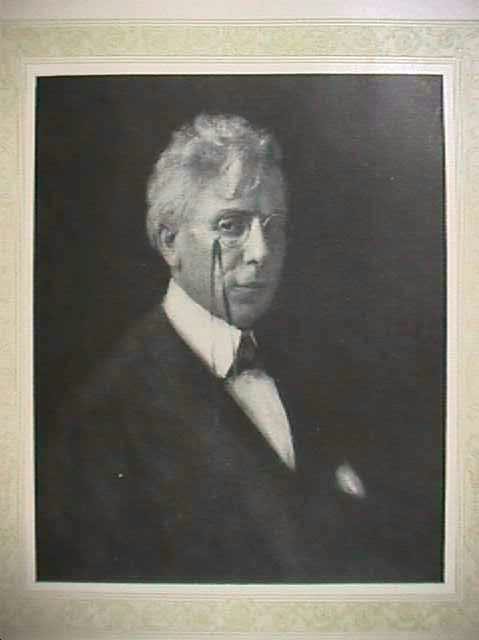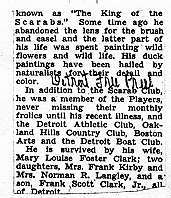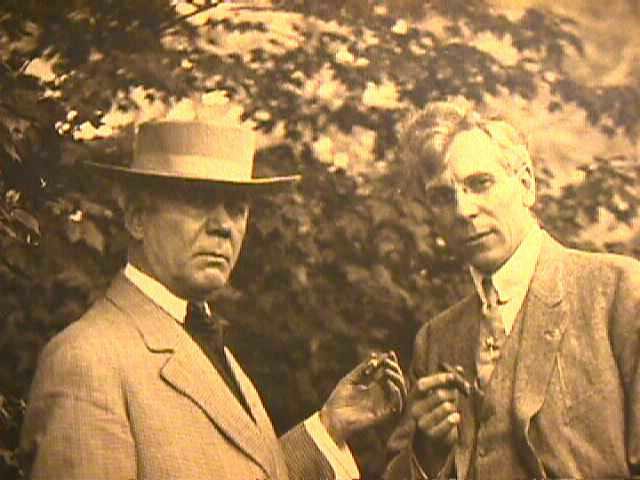Frank Scott Clark was ten years old when his
family lost their modest wealth in the largely unregulated business
and commercial environment of the 19th century.
He
began life September 16, 1865 in Peru, Indiana. Unfortunately family
records do not exist that relate any specific information about the Clark
family other than later statements by him that say his family went back to
Revolutionary War days, and that he was a direct descendant of the
explorer John Rogers Clark. Frank Scott Clark's future years seem to
form out of necessity as he began to fend for himself because of the
economic state of the family. Many moves follow his young years including
Canada and back to the eastern United States. Various jobs seem to have been
the course for young Clark, from a shoe manufacturer, to a shipyard
and carpentry, to painting barns and signs.
What
seems to be evident in all this is that to young Clark, these were learning
experiences, not drudgery of labor. He apparently invested his
skills into every next job opportunity to advance his knowledge in general,
and prove useful in finding a next rung up the ladder.
Probably
the most important aspect that led him on a path to photography initially
was his securing a job (ca.1880-81) in New York City with the pre-eminent
background painter
Lafayette W.
Seavey.
His backgrounds were becoming increasingly popular with portrait
photographers as the profession moved into the use of cabinet sized cards
in the late 1870's and became the rage in the 80's & 90's. This
position led to his being hired by the legendary New York portrait photographer
Napoleon
Sarony,
a friend of Seavey. Sarony seems to have almost been singularly
responsible for the advent of celebrity photos. His instincts that people
wanted to have a picture of a theater personality - especially women - made
Sarony a photographer to recon with when making money by means of mass
distribution. Sarony had already created a name for himself in the
field of lithography and perhaps that is where the idea for mass distribution
at relatively low prices came from. Clark not only made/created/set-up
backgrounds for Sarony but according to Clark, he also worked as a camera
operator in Sarony's stable. Seldom can any artisan produce volume
work without calling on others to handle some of the actual artistic production.
After
several years with Sarony, and a brief study/work time with another noted
New York City photographer Jose Maria Mora (also a former Sarony protege),
Clark struck out on his own. For a few years he had to maintain
his economic life doing both portraiture and odd-job painting productions
such as theater sets, photographers background artwork and various odd jobs
- but Clark's variety of skills in the trades, painting, and
photography all seem to have served him well by being able to provide unusual
and varied services to a broad range of clients.
In
1892 Clark comes to Detroit and for a short time is listed as manager
of the Charles |A. Millard Studio Estate, Millard apparently died ca 1891.
Clark joins with George Huntington as "Huntington & Clark" in 1894,
the studio overlooking Grand Circus Park at 224 Woodward Av.
A
photographer named Lyman B. Avery was listed as Manager of the Millard Studio
Estate in 1891. The partnership with George Huntington lasted till 1903-when
Clark began operating on his own and fast becomes connected with the upscale
side of Detroit society, along with its literary, artistic and theatrical
arenas. Clark's background and broad interests served him well in all
of these areas. But to say his success came from his knowledge and abilities
is to bely the fact that it takes a particular personality to "sell" oneself
to others. Obviously Frank Scott Clark was a man of warmth, charm,
and business accumen. Clark became a "larger-than-life" character of
the Detroit scene. He obviously made a goodly income.
He
became involved in the life of numerous Clubs, both artistic, social , literary
and sporting.
(one
of the founding members of the still extant Scarab Club; member of
Prismatic, Players , and Detroit Athletic clubs) . A typical
course for businessmen - you become part and parcel of your monied clients
interests, whether it be sporting, hunting, fishing, or theater
and music. They are the places where the social classes mix and trade
of business. It is not different today.
Clark
obviously traded on his personality and somewhat artistic dress as a slightly
bohemian figure, but at the same time knowledgeable in his conversations
in art, literature, theater and all the accepted tenents of being a cultured
person. In 1916 Clark moved again to the corner of Cass & Putnam,
another combination home/studio which continued to his death in 1937. This
house was situated at what is now the southwest corner of the Detroit Main
Library block. His building having two address; the studio being 5108
Cass Av., while the residential portion used the 114 Putnam address.
His second wife Mary was still at the address when she died in
1946.
Clark
never lost his interst in fine art painting. And in later years turned
more and more toward that aspect of his life. It was obviously this
is where he found the most personal artistic pleasure. Photography was also
enjoyable to Clark, but it was also his day to day business... painting was
his much loved avocation. He seems to have excelled in studies of nature,
especially birds. A recent sale on Ebay of one of Clark's oil's
of two ducks in flight bore a tag on the back as coming from the estate
of Henry Ford II.
Clark's
fondness for nature led him to purchase a large farm of about 400 acres plus
in the north, on Manitoulin Island in Canada. In 1924 he celebrated the
completion of a vertical log home which he called "Camp MaryAnne" - Mary
for his second wife, and Anne (or Annie) for his wife's sister Annie Ward
Foster, an inseperable trio for most of their years, according to various
accounts. The camp is still in existance today under that name as a private
summer vacation campground. The Clark's and their visiting guests of
Detroit businessmen and artisan- types are still talked about by old
timers whose memories can bring them back to the heyday of Frank Scott Clark,
1924 to 1937. It was here that Clark reportedly photographed native
indians and painted nature to his hearts content, unburdened by commerical
considerations.
Much
of what I have learned about Clark has come from published pieces, mainly
Detroit newspapers. A lengthy piece in the Detroit News dated Sunday,
June 19, 1919 gives a good broad overview (along with a portrait) of Clark's
life. Other smaller news pieces, many from "today's birthdays" pieces in
the Detroit News also fill in some of the particulars, as do the many obituary
pieces. I suspect there are more articles to find but this is the initial
recording for this website. And of course I must acknowledge Florence
"Betty" LaFrey, F.S. Clark's granddaughter - a spry 91 year-old "sparkplug"
of a woman. Betty remembers her grandfather well, although visits were
limited since her grandfather had divorced her grandmother.
"He
did have an eye for the ladies" she stated with some candor.
Because
of the divorce Clark was somewhat socially absent from his first family for
much of his life. And he had no children with his 2nd wife. Although
some items were apparently donated to the Scarab Club, much of Clark's
personal paperwork and momentoes have disappreared. It seems safe to assume
that his 2nd wife was not as interested in the perpetuation of her husband's
life's work; her own agenda seems to have been to focus on her own past career
as a dance teacher to the area's rich and famous. An unfortunate set of
circumstances to perpetuate his memory...




